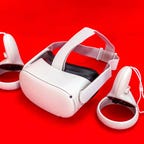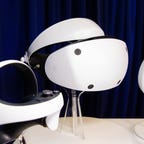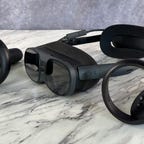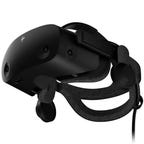 Why You Can Trust CNET
Why You Can Trust CNET Best VR Headsets of 2023: Our Top Picks of What We've Tested
The Quest 2 and PSVR 2 top our list, but here are some others to consider.
VR may be seen as a niche gaming hobby still, but it's plenty of fun for enthusiasts and casual fans alike, and there's a lot to get excited about for the future. However, you're better off spending as little as you can right now. The several-year-old Meta Quest 2, a self-contained $400 headset that's wireless, is still the best VR headset for most people, but the upcoming Meta Quest 3 could be worth waiting for. Sony's newly released $550 PlayStation VR 2, which delivers a best-in-class console VR experience for PlayStation 5 owners, is an excellent experience, but isn't wireless and is an expensive accessory. Still, it's our second favorite VR headset right now.
There's a new wave of mixed reality VR headsets, too, which blend VR with video of your surroundings with color passthrough cameras that feels almost like augmented reality. The $1,000 Meta Quest Pro has color cameras and eye tracking, but feels expensive for its minimal improvements. The $1,100 HTC Vive XR Elite is a similar type of product that's even smaller, but doesn't have included eye tracking. Expect Apple's upcoming and likely expensive headset to fall into similar territory.
The cost of a new VR headset is going up these days. The Quest 2 jumped in price last year. Even so, the Quest 2 still offers the best value in VR: a completely wireless experience, with access to a great library of fantastic games. It can also be connected to a PC to play games, such as Half-Life: Alyx, or to run a variety of PC VR applications. Meta keeps improving its software over time with added extras.
Anyone in the VR and AR industry who's looking to explore next-gen face tracking or mixed reality might consider the Quest Pro, but its high price means it won't make sense for anyone else right now. Keep in mind, Meta is releasing the Quest 3 this year, at a price that's expected to be similar to that of the Quest 2 and possibly with some features that are on the Quest Pro. (The Pico 4 gives some hints of how the Quest 3 could be upgraded.) You might want to wait for it, or for the other VR headsets on the horizon.
VR remains an impressive but still limited proposition for most people. Thanks to tremendous advancements in the visuals, tracking and overall performance of VR hardware, the best VR headset options have become more realistic and immersive. More advanced metaverse platforms and social worlds have given VR owners more to explore, too. Even so, VR still hasn't become a necessary product yet.
VR's strongest applications tend to be gaming and fitness. For fitness, a standalone headset like the Quest 2 is practically mandatory, to avoid wire tangles and make sure you can move around.
The Quest 2 is still the best VR headset right now, but more headsets are already on their way.
Qualcomm has been making headway on a wave of VR and AR headsets that plug right in to phones, but at the moment the software for these devices is a work in progress. Neither Google nor Apple supports VR at a seamless system level for phones yet, meaning devices have to figure out awkward solutions.
Meanwhile, Samsung, Google and Qualcomm have announced a partnership for future products, suggesting a mixed-reality headset could be arriving in the next few years. If you want a phone-connected device, you probably should wait and see how these Apple, Samsung and Google products shake out.
If you're a PC gamer, a PC-connected VR headset still offers the most versatile collection of software for an immersive VR experience, and it also lets you use that headset for creative and business tools. Note that a more powerful VR system will still be largely tethered to a desktop or laptop and may require external sensors.
And what about console gaming? The aging original PlayStation VR still exists, but you're better off getting the PSVR 2 if you have a PS5 and have the money to spend (and don't mind a tethered cable).
We update this best VR headset list periodically, but note that prices are subject to change.
The Quest 2 used to be $299, but a surprise price bump to $400 (or $500 for the version with more storage) has made Meta's two-year-old, self-contained VR headset even more expensive. But even with the increased price, the Quest 2 remains the best and most versatile VR headset of the moment. It's also, considering it requires no gaming console, phone or PC, the most affordable.
The $1,000 Quest Pro offers upgrades on the display, controllers, and adds features like better mixed reality and eye/face tracking, but its value for everyday VR explorers isn't worth the extreme cost. The Quest 2 remains the recommended pick until a Quest 3 arrives later this year.
The base model's 128GB of storage is plenty for storing dozens of games and apps, although keep in mind there's no way to add more storage after purchase. Meta also now allows accounts to bypass Facebook logins, although a new Meta account is still required.
The Quest 2 reminds me of the Nintendo Switch for its versatility and fun, and it has a growing library of surprisingly effective fitness apps. The Quest 2 can also connect with a PC to run more advanced apps from Steam or Meta's own app library, using a single USB-C cable or wirelessly.
The PSVR 2 is expensive ($550), and needs a PlayStation 5 to even work. It's tethered, not wireless. However, its HDR OLED display, graphics quality, built-in eye tracking and fantastic advanced controllers -- which have the same vibrations and adaptive force-feedback triggers as the PS5 DualSense controllers -- give this headset a premium feel that makes its best games perform at a different level. It could be a landing spot for top PC VR games, but right now it already has some exclusives like Gran Turismo 7, Resident Evil Village and Horizon: Call of the Mountain.
The PSVR 2 lacks any social metaverse-type software so far and feels more like a headset designed to just launch and play VR games. Many of the games for this headset are ports of titles you could get on devices like the Quest 2 instead. As more games roll out that are optimized for this hardware, however, the PSVR 2 could quickly stand out from the standalone VR pack. You might want to wait and see what happens, unless you're ready to jump in and trust Sony now.
Also reviewed:
Meta's step-up VR headset adds eye and face tracking, color passthrough cameras that help create mixed reality experiences, a different type of design that can fit more easily over glasses, smaller controllers that have their own tracking cameras, and a much higher price than the Quest 2. The Quest Pro runs the same apps and software as the Quest 2, and can also work as a PC-connected headset. The Quest Pro is intended as a work-focused pro tool, and doesn't feel optimized for gaming. But it also isn't truly optimized for most people's work needs, either, since VR headsets still aren't seamless tools with PCs and phones. The Quest Pro's display resolution and lens quality is considerably better than the Quest 2, though. It's likely a preview of some of the upgrades we'll see in the Quest 3, which you should wait for.
The nearly glasses-like XR Elite headset seems at first glance like it's a pair of weird glasses. It's a full standalone headset like the Quest Pro, and can also do passthrough mixed reality. It's also PC compatible. The XR Elite's advantage is its size, but its software feels far behind where Meta is at for standalone apps and features. It does show how future hardware is likely to get even smaller and more modular, but this isn't the answer yet.
If your idea of the best VR headset is to have the best image quality in consumer VR, HP's Reverb G2 wins. For serious gamers (or VR racing sim fans), it's probably your best choice. The 2,160x2,160-per-eye resolution and 114-degree field of view are the best at this price range, and the lightweight, comfy headset also has fantastic dropdown speakers designed by Valve. It's technically a Microsoft Windows mixed reality headset that prefers to launch into Microsoft's native Windows 10 VR ecosystem, but it bridges with Steam VR and works with those games and apps, too. Built-in camera-based room-tracking is easier to set up than the Valve Index's external base stations, but is more prone to tracking errors. The included controllers, based on Microsoft's VR controller design, feel clunkier than either the Quest 2 controllers or the Valve Index controllers. Also, the over-ear speakers are your only audio choice; there's no headphone jack.
It typically lists for $599, but it's often been on sale for less.
Valve's headset isn't as cutting-edge as it was when it debuted in 2020, but its Steam VR and Vive hardware compatibility, its excellent audio and its fancy controllers still make it hardware worth considering. Valve's "knuckle" controllers are pressure-sensitive and can track all five fingers, making them almost like gloves. Not all apps make the most of them, but Valve's hardware is mix-and-match compatible with the HTC Vive, which also is built on the Steam VR platform. The Index headset has excellent audio and a sharp, wide-field-of-view display, but its display resolution isn't as good as competitors.
The Index works with external "lighthouse" boxes similar to the HTC Vive, meaning you need to set those up in a room first. It's not as self-contained as the Quest 2 or HP Reverb G2, which can track the room with in-headset cameras. It's also definitely not wireless, but if you already have some older HTC Vive hardware, you could add on parts of the Index to mix and match. It feels like this hardware could be due for an upgrade sooner than later.
How we test VR headsets
Even though mainstream VR headsets have been around for nearly a decade, the apps they run and the computers, phones and game consoles they work with keep changing. We run key apps and software on the headsets, using them mainly in standalone mode if they're designed to be self-contained, or with a PC, game console or phone if they're primarily meant as connected peripherals. We use the headsets for a mix of work, gaming, fitness and creative uses, and stay attentive for where the headsets have pain points (moments of discomfort, feelings of disconnect, or sensations of nausea or distortion). Using technology like VR can often be a highly subjective experience, but by being attentive to details we find we can discover where each product is uniquely useful. Comparison is also key: I've looked at pretty much every wearable AR and VR device of the last 15 years, and also covered a lot of the wearable tech, phone and computer landscape. How these devices work as game consoles, fitness devices, work accessories and social tools are all key areas. We also think about displays, audio, controllers and accommodations for eyeglasses.
VR FAQs
Should I wait to buy a VR headset?
It's not a bad idea. With the Quest 3 and Apple's mystery device expected this year, there may be many devices on the way that are better than what's here at the moment. VR is a technology that's still in flux, with companies aiming for products that are smaller and more able to be connected to devices like phones. It's probably best to spend as little as possible to avoid investing in outdated gear.
What should I look for in a VR headset?
It depends, really, on whether you're connecting to a PC or not... and whether you plan to do work with it. There are plenty of Windows-compatible headsets, but they vary in display resolution. Higher is better, and so is a larger field of view. Headsets can refresh at up to 120Hz now, and the faster they refresh, the more natural and smooth VR movement feels.
Most PC VR headsets have similar controller designs and can bridge to work tools and apps. For portability or standalone comfort, the Quest 2 doesn't have much competition right now. For gamers with a PlayStation 5, the PSVR 2 is the best option. Also, consider the app libraries: The Quest has a lot of exclusive games, Windows-connected headsets have lots of compatibility with work apps and experimental tools. The PSVR 2 has its own library of games that aren't backward-compatible with original PSVR games.
Do any of these headsets work with phones?
The old world of phone-based VR headsets -- like the Samsung Gear VR and Google Daydream -- are basically dead. A good number of the current iPhone, Android and VR app options don't even work with the old mobile VR goggles. The Quest 2 does have a phone app for streaming content for a parent to monitor, and can receive phone notifications and sync some health data for workouts, but it's still not fully integrated with phones. If smartphone-based VR comes back, it will more likely be in the form of small headsets that plug into phones via USB-C for VR content, VR gaming and other uses.
How do I care for my VR headset?
VR headsets can get dusty and grimy. Take extra care with the lenses, which should be cleaned gently with microfiber cloths the same way you'd treat glasses (but don't use liquid cleaners). A slightly damp paper towel (just wet with a bit of water) can help clean off exteriors. It's a good idea to invest in a case or bag to protect the headset from dust, and keep your headset covered when not in use.
Take extra care not to expose your VR headset to bright sunlight: The sun can damage VR displays if beams hit the lenses of the headset. To be safe, I keep mine in cases, turn the lenses away from windows, and cover them with an old t-shirt or towel if I don't have a case.






